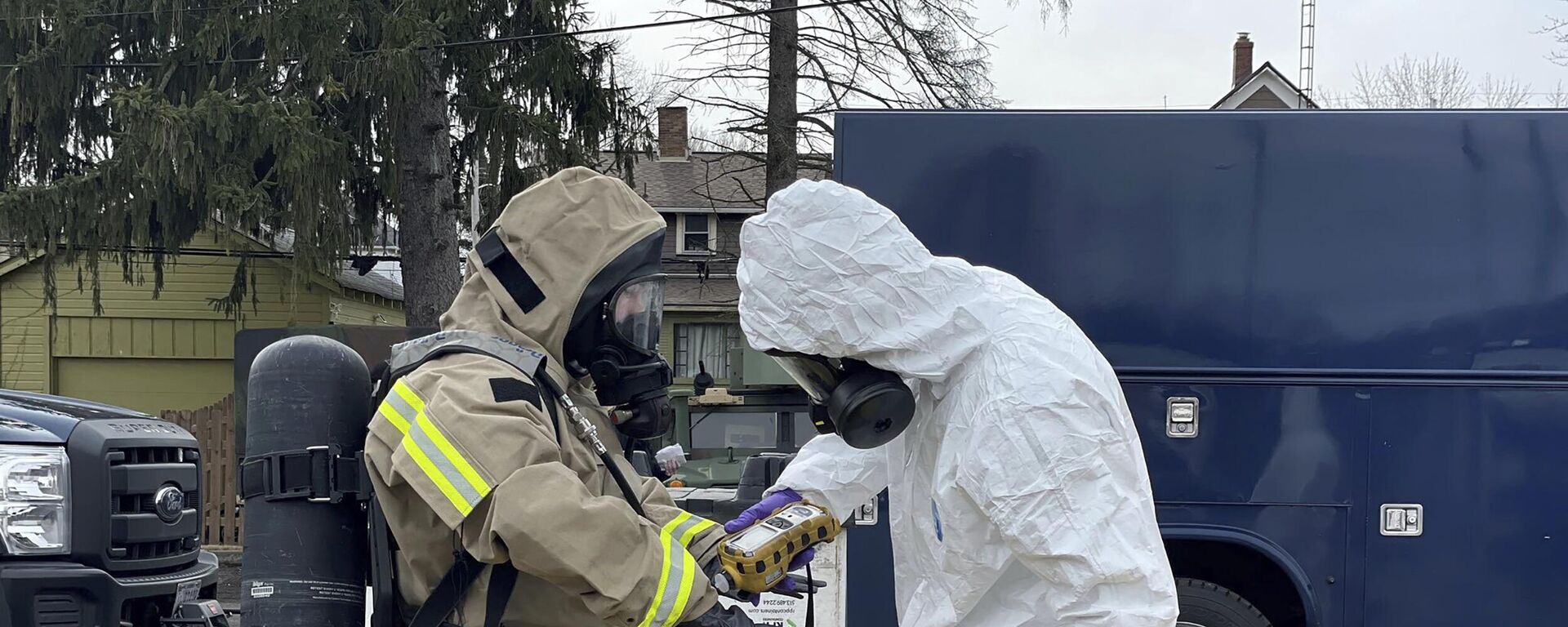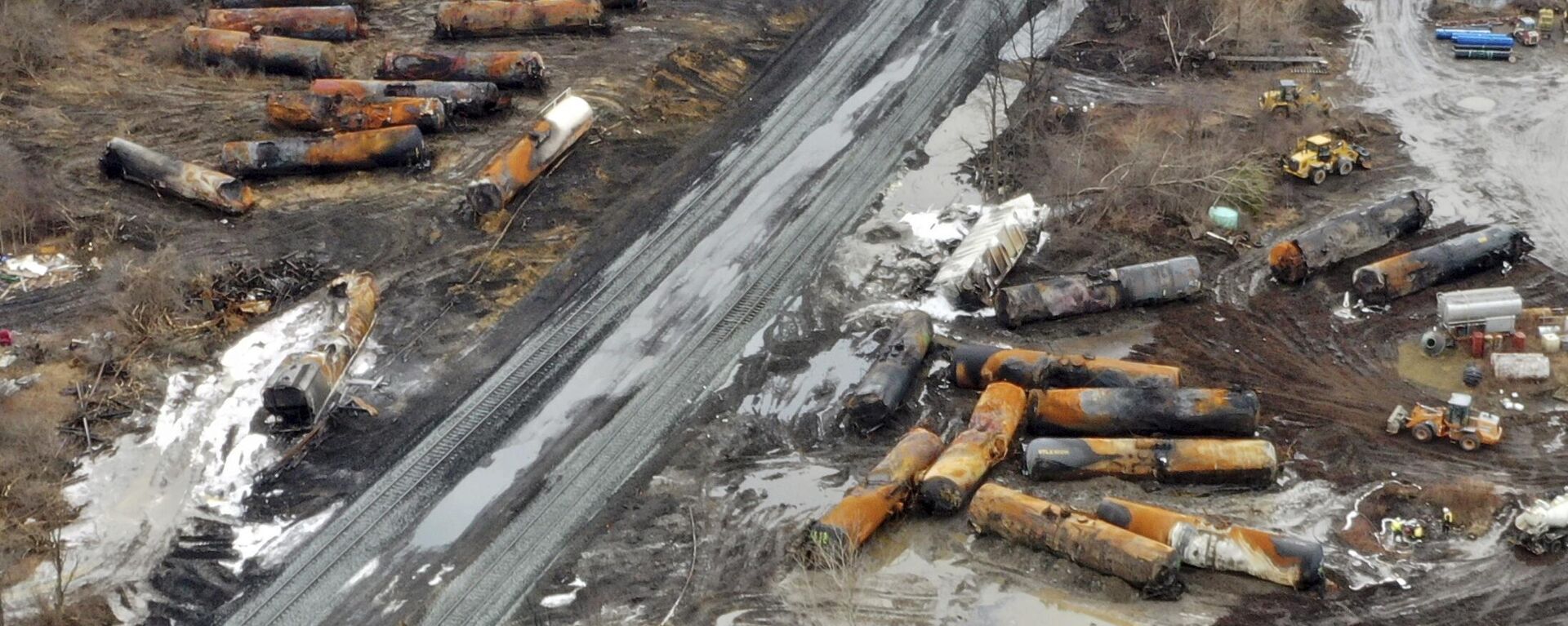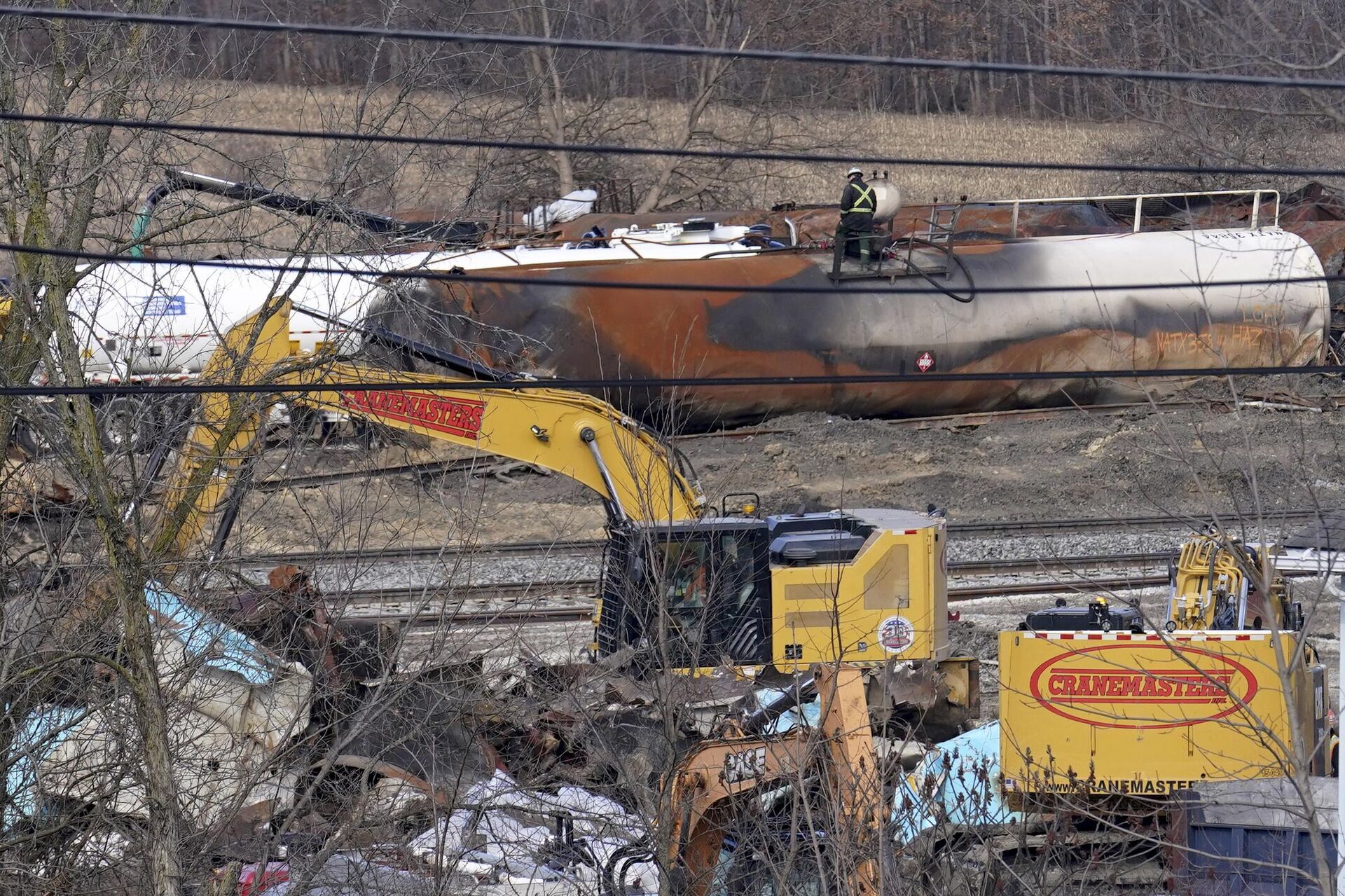https://sputnikglobe.com/20230224/ohio-train-wreck-100-preventable-could-have-been-avoided-with-earlier-warning-ntsb-chair-says-1107764216.html
Ohio Train Wreck '100% Preventable,' Could Have Been Avoided With ‘Earlier Warning,’ NTSB Chair Says
Ohio Train Wreck '100% Preventable,' Could Have Been Avoided With ‘Earlier Warning,’ NTSB Chair Says
Sputnik International
The toxic train derailment in Ohio might have been avoided with an earlier warning of overheated bearings, revealed preliminary investigation.
2023-02-24T10:30+0000
2023-02-24T10:30+0000
2023-02-24T10:30+0000
us
ohio
train derailment
us national transportation safety board (ntsb)
toxic chemicals
americas
https://cdn1.img.sputnikglobe.com/img/07e7/02/18/1107762973_0:155:3000:1843_1920x0_80_0_0_922fef4ab580ce56df0b6dc520ccf3a9.jpg
The train derailment in East Palestine, Ohio that resulted in a spill of toxic chemicals might have been avoided if crews had been given an earlier warning that the axle bearing was overheated, the Chair of the National Transportation Safety Board (NTSB ) said. After federal investigators released a preliminary report on the incident, Chair Jennifer Homendy told the media on February 23:"Had there been a detector earlier, that derailment may not have occurred."According to investigators, the temperature of the wheel bearing that was possibly one of the reasons for the derailment surged by 215 degrees as the train covered 30 miles (48 kilometers). However, the spike in temperature did not reach the threshold that the railroad company - Norfolk Southern - had set for an alarm to go off until it was too late. Thus, the three-person train crew failed to receive an early indication that there was trouble with the axle bearings and the “critical audible alarm message" only went off just before the derailment. According to the report, the engineer then slowed, stopped the train, and upon seeing fire and smoke, the crew alerted dispatch. "During the deceleration, the wheel bearing failed... Car 23 derailed, and the train initiated an emergency brake application and came to a stop,” said the NTSB Chair, adding that the derailment was “100% preventable." She said there is no evidence the train’s crew “did anything wrong.”The 38-car train was moving at a speed of about 47 mph (75 kph), which is under the speed limit of 50 mph (80 kph), according to investigators. According to media-cited experts, the sensors recording temperatures in the case of the Norfolk Southern train were 10 and 20 miles (16 to 32 kilometers) apart, which is typical for the industry.According to Homendy, investigators will further probe if the industry safety standards that include high-temperature alarm thresholds and sensor spacing ought to be revised. According to Homendy, it was “too early to tell” for sure what might have helped prevent the disaster.The train cars that derailed near the Ohio-Pennsylvania border included “11 tank cars carrying hazardous materials that subsequently ignited, fueling fires,” the NTSB said in its preliminary report. Five of the cars carried 115,580 gallons of highly flammable vinyl chloride. These carriages “continued to concern authorities because the temperature inside one tank car was still rising,” signaling a polymerization reaction that could result in an explosion, which prompted crews to release the chemical into a trench and burn it three days after the derailment to avoid an explosion, the findings said.The NTSB will be holding an "investigative field hearing" near the site of the incident in East Palestine and inviting witnesses.The accident has left residents voicing deep concern over the long-term health impact of the millions of pounds of carcinogenic chemicals spilled in their town.
https://sputnikglobe.com/20230220/1107611074.html
https://sputnikglobe.com/20230223/ohio-resident-decries-infrastructure-neglect-that-led-to-string-of-disasters-1107738374.html
ohio
americas
Sputnik International
feedback@sputniknews.com
+74956456601
MIA „Rossiya Segodnya“
2023
News
en_EN
Sputnik International
feedback@sputniknews.com
+74956456601
MIA „Rossiya Segodnya“
Sputnik International
feedback@sputniknews.com
+74956456601
MIA „Rossiya Segodnya“
toxic train derailment, ohio, east palestine, avoided with earlier warning, overheated bearings, 100% preventable, spill of toxic chemicals, had there been a detector earlier, wheel bearing failed, no evidence, train crew did nothing wrong, high-temperature alarm thresholds, sensor spacing
toxic train derailment, ohio, east palestine, avoided with earlier warning, overheated bearings, 100% preventable, spill of toxic chemicals, had there been a detector earlier, wheel bearing failed, no evidence, train crew did nothing wrong, high-temperature alarm thresholds, sensor spacing
Ohio Train Wreck '100% Preventable,' Could Have Been Avoided With ‘Earlier Warning,’ NTSB Chair Says
The Ohio, East Palestine derailment of February 3 has sparked a blame game over railroad safety regulations, as the Biden administration has faulted Norfolk Southern for neglect and the administration of his predecessor, Donald Trump, for loosening safety technology regulations on railroad companies during his tenure.
The
train derailment in East Palestine, Ohio that resulted in a spill of toxic chemicals might have been avoided if crews had been given
an earlier warning that the axle bearing was overheated, the Chair of the National Transportation Safety Board (NTSB ) said.
After federal investigators
released a preliminary report on the incident, Chair Jennifer Homendy told the media on February 23:
"Had there been a detector earlier, that derailment may not have occurred."
According to investigators, the temperature of the wheel bearing that was possibly one of the reasons for the derailment surged by 215 degrees as the train covered 30 miles (48 kilometers). However, the spike in temperature did not reach the threshold that the railroad company - Norfolk Southern - had set for an alarm to go off until it was too late.
Thus, the three-person train crew failed to receive an early indication that there was trouble with the axle bearings and the “critical audible alarm message" only went off just before the derailment. According to the report, the engineer then slowed, stopped the train, and upon seeing fire and smoke, the crew alerted dispatch.
"During the deceleration, the wheel bearing failed... Car 23 derailed, and the train initiated an emergency brake application and came to a stop,” said the NTSB Chair, adding that the derailment was “100% preventable."
"We call things accidents – there is no accident. Every single event that we investigate is preventable.”
She said there is no evidence the train’s crew “did anything wrong.”

20 February 2023, 12:48 GMT
The 38-car train was moving at a speed of about 47 mph (75 kph), which is under the speed limit of 50 mph (80 kph), according to investigators. According to media-cited experts, the sensors recording temperatures in the case of the Norfolk Southern train were 10 and 20 miles (16 to 32 kilometers) apart, which is typical for the industry.
According to Homendy, investigators will further probe if the industry safety standards that include high-temperature alarm thresholds and sensor spacing ought to be revised. According to Homendy, it was “too early to tell” for sure what might have helped prevent the disaster.
“It could be regulation changes. It could be recommendations to Norfolk Southern, to the Department of Transportation or to rail car manufacturers or to emergency responders. But again, it’s too early to tell,” Homendy said.
"NTSB investigators identified and examined the first railcar to derail, the 23rd railcar in the consist. Surveillance video from a local residence showed what appeared to be a wheel bearing in the final stage of overheat failure moments before the derailment," the NTSB's preliminary report said.
The train cars that derailed near the Ohio-Pennsylvania border included “11 tank cars carrying hazardous materials that subsequently ignited, fueling fires,” the NTSB said in its preliminary report. Five of the cars carried 115,580 gallons of highly flammable vinyl chloride. These carriages “continued to concern authorities because the temperature inside one tank car was still rising,” signaling a polymerization reaction that could result in an explosion, which prompted crews to release the chemical into a trench and burn it three days after the derailment to avoid an explosion, the findings said.
The NTSB will be holding an "investigative field hearing" near the site of the incident in East Palestine and inviting witnesses.

23 February 2023, 15:13 GMT
The accident has left residents voicing deep concern over the long-term health impact of the millions of pounds of carcinogenic chemicals spilled in their town.






